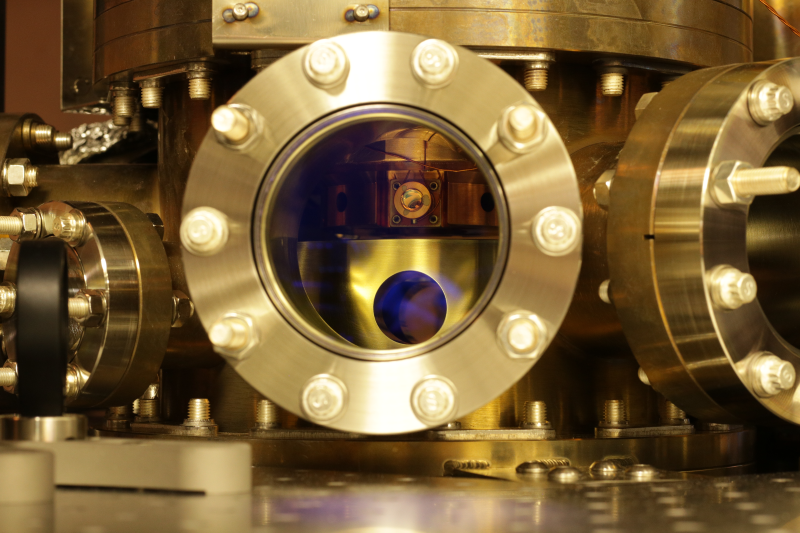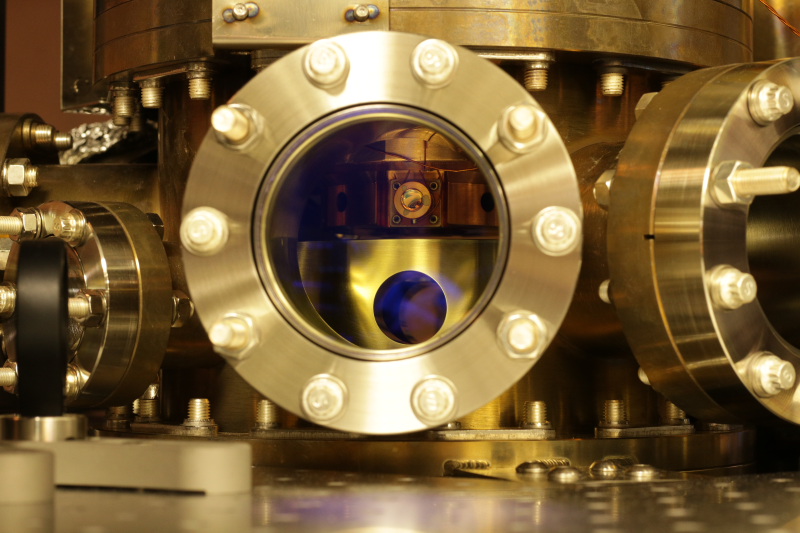Squeezing More out of Atomic Clocks
Today’s best atomic clocks gain or lose at most 1 second every 15 billion years, longer than the Universe has been around. That is plenty stable for current atomic-clock applications in global positioning systems, telecommunications networks, and stock-trading systems, for example. But clock improvements could open further uses. Now John Robinson, Jun Ye, and their colleagues at the University of Colorado Boulder demonstrate that they can use quantum effects to increase the precision of a state-of-the-art atomic clock [1]. More precise clocks could aid in searches for dark matter, early warning systems for volcanic eruptions, and cosmos-spanning navigation. “If humankind is going to conquer the Solar System and settle on different planets, we will need communication and navigation devices with more precise atomic clocks,” Ye says.
Atomic clocks define ticks using the oscillations of electromagnetic waves emitted by atoms as they transition between energy states. Researchers can increase the precision of any given atomic clock by using better hardware, such as more stable lasers, to drive the clock’s ticks. But hardware updates can only take them so far, Robinson says. Increasing performance further requires packing more atoms into a clock. The more atoms there are, the more oscillations researchers can simultaneously track. More measurements mean a higher signal-to-noise ratio, which leads to a more precise clock.
But, Robinson notes, that route to precision improvement also comes with restrictions. “There is a practical limit—it gets physically harder and harder to add in atoms as their number increases,” he says. “When the atom density goes above a certain point, the atoms start to interact, and that can change how they behave.” Luckily, there is a third avenue for making a more exact clock: “spin squeezing” the atoms.
Like all objects that operate in the quantum realm, atoms in atomic clocks can exist in multiple energy states at once. Spin squeezing can entangle the atoms, which quantumly correlates their states and reduces the quantum noise associated with each particle. Clocks with spin-squeezed atoms thus have a lower background noise and so can be more precise.
Robinson, Ye, and their colleagues have employed spin squeezing in an atomic clock with optimized hardware and atomic density. “We aren’t the first to use spin squeezing in an atomic clock,” Ye says. “But we are the first to fully integrate the process within a state-of-the-art atomic clock and show that it matters—it can make the clock better.” Philipp Treutlein, who studies spin squeezing at the University of Basel, Switzerland, offers the same view of the advance. “Indeed, a number of previous experiments have used spin squeezing to enhance atom interferometers or atomic clocks, but those experiments operated at precision levels far from the state of the art,” he says.
The team’s clock contained 10,000 strontium atoms cooled to 290 nanokelvin and trapped in an optical lattice made from two counter-propagating laser beams. The lattice appeared as a series of horizontally aligned rows, one half of which fit at any one time within an optical cavity made from two mirrors. The team used another laser to spin squeeze the atoms and a fourth to initialize the clock.
Before running the clock, the researchers divided the atoms into two subpopulations, one above the other. Detuning one of the lasers used to trap the atoms, they lowered all the rows until only the top subpopulation sat within the cavity. They then performed spin squeezing on that subpopulation, entangling those atoms. Afterward, they repeated the detuning and spin-squeezing steps for the bottom population. This process created two independently entangled atom ensembles, which the researchers were then able to separately manipulate and measure, effectively creating two clocks within one.
Robinson and his colleagues showed that the spin squeezing improved the precision of the clocks by a factor of 1.5. Ye and Robinson both say that the key to the success was having two clocks within one. That allowed them to directly monitor the performance of the system without having to set up a reference clock or perform any complex measurements on the system. Both those options can add significant noise from the lasers used to make the measurements. “The measurements drown in laser noise,” Robinson says. Here the laser is common to both clocks, so its noise naturally cancels out when the two clock measurements are compared.
“This work constitutes very exciting progress,” says Vladan Vuletić, who works at the Massachusetts Institute of Technology and develops techniques to improve atomic-clock precision. “[The team] shows that entanglement can improve a state-of-the-art clock and paves the way toward even more precise clocks, enabled by entanglement. Such precise clocks could be used to test some of the basic laws of physics.” Treutlein notes that work remains before researchers can perform such tests. But, he says, the demonstration of Ye, Robinson, and their colleagues “shows that spin squeezing is becoming a quantum technology of practical relevance in metrology.”
Metrological measurements and tests of fundamental physics were a key motivation of the work, Robinson says. If implemented in today’s best atomic clocks, squeezing could make these devices sensitive to fluctuations in some of the fundamental constants of the Universe, which certain dark matter models predict should vary in time. “Theorists are very good at cooking up all these different ideas,” Robinson says. “Improved atomic clocks could provide a way to test them.”
Correction (17 January 2024): The original article incorrectly stated that Robinson, Ye, and their colleagues increased the precision of their clock by a factor of nearly 2. Rather it was a factor of 1.5.
–Katherine Wright
Katherine Wright is the Deputy Editor of Physics Magazine.
References
- J. M. Robinson et al., “Direct comparison of two spin-squeezed optical clock ensembles at the 10−17 level,” Nat. Phys. (2024).





